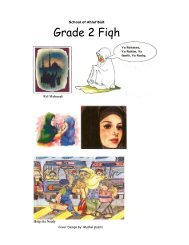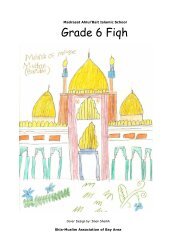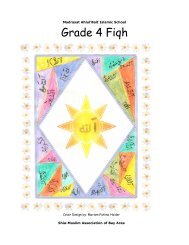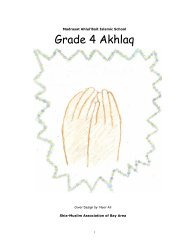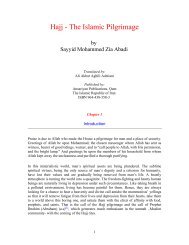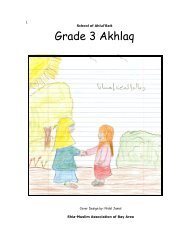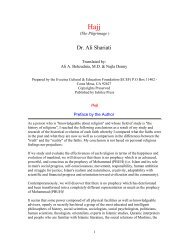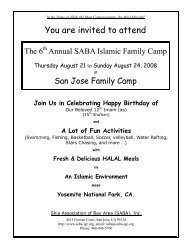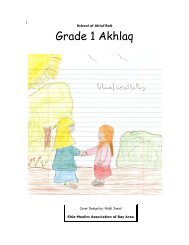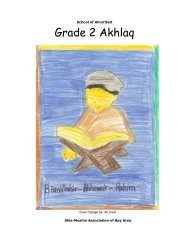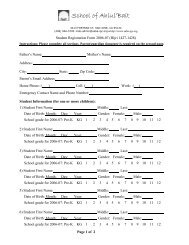Grade 1 Fiqh Book (PDF) - Shia Multimedia
Grade 1 Fiqh Book (PDF) - Shia Multimedia
Grade 1 Fiqh Book (PDF) - Shia Multimedia
You also want an ePaper? Increase the reach of your titles
YUMPU automatically turns print PDFs into web optimized ePapers that Google loves.
1.<br />
Madrasat Ahlul’Bait Islamic School<br />
<strong>Grade</strong> 1 <strong>Fiqh</strong><br />
Cover Design by: Muhammad Fawaz<br />
<strong>Shia</strong>-Muslim Association of Bay Area
First Edition (Revision 1.0)<br />
First Printing September 10, 2006<br />
Compilers and Co-Authors:<br />
Samina Ali, Member Syllabus Committee,<br />
Madrasat Ahlul’Bait, <strong>Shia</strong>-Muslim Association of Bay Area<br />
Editors:<br />
Sister Urooj Kazmi, Chair Syllabus Committee,<br />
Madrasat Ahlul’Bait, <strong>Shia</strong>-Muslim Association of Bay Area<br />
Copyright Free & Non-Profit Notice:<br />
Madrasat Ahlul’Bait curriculum material can be freely copied, duplicated, reproduced, quoted,<br />
distributed, printed, used in derivative works and saved on any media and platform for non-profit<br />
and educational purposes only. A fee no higher than the cost of copying may be charged for the<br />
material.<br />
Note from Madrasat Ahlul’Bait:<br />
The Publishers and the Authors have made every effort to present the Quranic verses, prophetic<br />
and masomeen traditions, their explanations and the material from the sources referenced in an<br />
accurate, complete and clear manner. We ask for forgiveness from Allah (SWT) and the readers if<br />
any mistakes have been overlooked during the review process.<br />
Contact Information:<br />
Any correspondence related to this publication and all notations of errors or omissions should be<br />
addressed to Syllabus Committee, Madrasat Ahlul’Bait, <strong>Shia</strong>-Muslim Association of Bay Area at<br />
saba@saba-igc.org.<br />
Published by:<br />
Madrasat Ahlul’Bait<br />
<strong>Shia</strong>-Muslim Association of Bay Area<br />
4415 Fortran Court, San Jose, CA 95134, USA<br />
www.saba-igc.org<br />
saba@saba-igc.org<br />
LIMIT OF LIABILITY/DISCLAIMER OF WARRANTY: THE PUBLISHER AND THE AUTHORS MAKE NO REPRESENTATIONS<br />
OR WARRANTIES WITH RESPECT TO THE ACCURACY OR COMPLETENESS OF THE CONTENTS OF THIS WORK AND<br />
SPECIFICALLY DISCLAIM ALL WARRANTIES, INCLUDING WITHOUT LIMITATION WARRANTIES OF FITNESS FOR A<br />
PARTICULAR PURPOSE. NO WARRANTY MAY BE CREATED OR EXTENDED BY SALES OR PROMOTIONAL MATERIALS.<br />
THE ADVICE AND STRATEGIES CONTAINED HEREIN MAY NOT BE SUITABLE FOR EVERY SITUATION. NEITHER THE<br />
PUBLISHER NOT THE AUTHORS SHALL BE LIABLE FOR DAMAGES ARISING HEREFROM. THE FACT THAT AN<br />
ORGANIZATION, BOOK OR WEBSITE IS REFERRED TO IN THIS WORK AS A CITATION AND/OR A POTENTIAL SOURCE<br />
OF FURTHER INFORMATION DOES NOT MEAN THAT THE AUTHORS OR THE PUBLISHER ENDORSES THE<br />
INFORMATION THE ORGANIZATION OR WEBSITE MAY PROVIDE OR RECOMMENDATIONS IT MAY MAKE. FURTHER,<br />
READERS SHOULD BE AWARE THAT BOOKS AND INTERNET WEBSITES LISTED IN THIS WORK MAY HAVE CHANGED<br />
OR DISAPPEARED BETWEEN WHEN THIS WORK WAS WRITTEN AND WHEN IT IS READ. SHIA ASSOCIATION OF BAY<br />
AREA IS NOT ASSOCIATED WITH ANY ORGANIZATION, PRODUCT OR VENDOR MENTIONED IN THIS BOOK.<br />
2<br />
<strong>Grade</strong> 1 <strong>Fiqh</strong>
Table of Contents<br />
Table of Contents ...........................................................................................................3<br />
Foreword ........................................................................................................................5<br />
Section I: Islamic Beliefs (<strong>Fiqh</strong>) ....................................................................................6<br />
Chapter 1: Usul-e-Din (Roots of Islam)......................................................................7<br />
1.1 Usul-e-din (roots of religion) are 5 .............................................................................................8<br />
1.2 Worksheet: Usul-e din are Five ..................................................................................................9<br />
1.3 Worksheet: What are 5 Usul-e-Din...........................................................................................10<br />
1.4 Worksheet: Find the Missing Usul-e-Din.................................................................................11<br />
Chapter 2: Allah is Qadeem - Allah has no Beginning or End.................................12<br />
2.1 Worksheet: Allah is Qadeem ....................................................................................................13<br />
Chapter 3: Allah is Alim - Allah Knows Everything................................................14<br />
3.1 Worksheet: Allah is Alim .........................................................................................................15<br />
Chapter 4: Allah is Mutakallim - Allah can make Everything Talk.........................16<br />
4.1 Worksheet: Allah is Mutakallim...............................................................................................17<br />
Chapter 5: Allah is Qadir - Allah is the Strongest and the Most Powerful...............18<br />
5.1 Worksheet: Allah is Qadir ........................................................................................................20<br />
5.2 Worksheet: Only Ask Allah (swt) for Help ..............................................................................21<br />
Chapter 6: Prophets and Imams ................................................................................22<br />
6.1 Worksheet: Prophets and Imams I ............................................................................................23<br />
6.2 Worksheet: Prophets and Imams II...........................................................................................24<br />
6.3 Worksheet: First Imam (a) ........................................................................................................25<br />
6.4 Worksheet: Last Imam..............................................................................................................26<br />
Chapter 7: Ahlul bait are Like the Ark of Prophet Nuh (a) ......................................27<br />
7.1 Worksheet: Ahlul bait are Like the Ark of Prophet Nuh (a).....................................................28<br />
7.2 Worksheet: Color and Count the Hearts ...................................................................................29<br />
Chapter 8: Furoo-e-deen............................................................................................30<br />
8.1 Worksheet: Furoo-e-deen..........................................................................................................31<br />
8.2 Worksheet: Label the branches of tree of Islam and color it. ...................................................32<br />
Chapter 9: Wudhu .....................................................................................................33<br />
9.1 Worksheet: Wudhu sunnat Actions ..........................................................................................34<br />
9.2 Wajib Actions of Wudu ............................................................................................................35<br />
9.3 Worksheet: Wudhu Wajib Actions ...........................................................................................37<br />
9.4 Complete Wudu - Revision.......................................................................................................38<br />
9.5 Complete Wudhu: Practical Demonstration .............................................................................39<br />
Chapter 10: Adhan and Iqama .................................................................................40<br />
10.1 Whole Adhan ..........................................................................................................................41<br />
10.2 Iqama.......................................................................................................................................42<br />
10.3 Worksheet: Adhan and Iqamah...............................................................................................43<br />
Chapter 11: Saalat (daily prayers) ...........................................................................44<br />
11.1 Worksheet: Salaat ...................................................................................................................45<br />
11.2 Worksheet: Write the names of the Salaat on the pillars of Masjid and color........................46<br />
<strong>Grade</strong> 1 <strong>Fiqh</strong> 3
11.3 Worksheet: Salaat crossword..................................................................................................47<br />
Chapter 12: Actions of Salaat ..................................................................................48<br />
12.1 Worksheet: Number the actions of Salaat in their correct order.............................................49<br />
Chapter 13: Different parts of the body that should touch ground during Sajda ....50<br />
13.1 Worksheet: Different parts of the body that should touch ground during Sajda ....................51<br />
13.2 Worksheet: Color the right Mohr............................................................................................52<br />
Chapter 14: Amr bil Ma'roof (Guide others to the Good)......................................53<br />
14.1 Worksheet: Amr bil Ma'roof...................................................................................................55<br />
Chapter 15: Kalima (review) ...................................................................................56<br />
15.1 Worksheet: Kalima .................................................................................................................57<br />
15.2 Worksheet: Write Numbers 2 to 12 in Stars ...........................................................................58<br />
15.3 Worksheet: Color the Hearts...................................................................................................59<br />
Chapter 16: Angels and Shaytan..............................................................................60<br />
16.1 Worksheet: Angels and Shaytan .............................................................................................62<br />
Chapter 17: Awareness of living Imam (as)-1.........................................................63<br />
17.1 Worksheet: Awareness of Living Imam (a) -1 .......................................................................64<br />
Chapter 18: Awareness of living Imam (as) -2........................................................66<br />
18.1 Worksheet: Awareness of Living Imam (a)-2 ........................................................................67<br />
18.2 Worksheet: A Letter to Imam Mahdi (a) ................................................................................68<br />
18.3 Worksheet: Title of Imam (a) .................................................................................................69<br />
SECTION II: Special Occasions..................................................................................70<br />
Chapter 19: Sawm....................................................................................................71<br />
19.1 Worksheet: Sawm ...................................................................................................................72<br />
19.2 Dua for Breaking the fast........................................................................................................73<br />
19.3 Worksheet: Favorite Foods for Iftaar......................................................................................74<br />
19.4 Worksheet: The Month of Ramadhan.....................................................................................75<br />
Chapter 20: Hajj.......................................................................................................76<br />
20.1 Worksheet: Boys in Ehram .....................................................................................................77<br />
20.2 Worksheet: Color the Ka’aba..................................................................................................78<br />
Acknowledgements......................................................................................................79<br />
4<br />
<strong>Grade</strong> 1 <strong>Fiqh</strong>
In the Name of Allah the Most Gracious Most Merciful<br />
Foreword<br />
The material presented in this document is a result of an effort made by the<br />
personnel of the school of Ahlul’Bait of the <strong>Shia</strong>-Muslim Association of Bay Area<br />
Islamic Center at San Jose, California in cooperation with several schools of<br />
Ahlul’Bait at London-Stanmore, London-Hujjat, Vancouver, Minnesota and Toronto.<br />
We, at San Jose, looked at material from London-Stanmore, London-Hujjat,<br />
Vancouver, Minnesota, Toronto and Irvine's Islamic institutions, as well as that<br />
available at various web-sites to compile age appropriate textbooks for use by our<br />
students. We thank the institutions that were kind enough to provide us with the<br />
electronic files of their curriculum. We used some of what they had and added to it<br />
what we felt was appropriate. We included more worksheets and pictures where<br />
deemed necessary. We also added some new topics that, we felt are important to<br />
the students.<br />
We had two important goals in mind while working on this document. First, introduce<br />
the students to the important Islamic concepts and beliefs that are crucial for him/her<br />
to know. Second, expose the students to as many Quranic verses and sayings from<br />
Prophet Muhammad (p) and his Ahlul’Bait (a) as possible.<br />
We thank Hujjatul Islam Maulana Nabi Raza Abidi for his spiritual guidance. We hope<br />
future efforts will continue taking place until reaching our goal of having a strong, rich<br />
and unified curriculum for the schools of Ahlul’Bait for all ages.<br />
Syllabus Committee<br />
Madrasat Ahlul’Bait<br />
<strong>Grade</strong> 1 <strong>Fiqh</strong> 5
Section I: Islamic Beliefs (<strong>Fiqh</strong>)<br />
6<br />
<strong>Grade</strong> 1 <strong>Fiqh</strong>
Chapter 1:<br />
Usul-e-Din (Roots of Islam)<br />
Just as a tree is made up of roots and branches so is the religion of Islam.<br />
Usul-e-din = the roots of the religion<br />
Furoo-e-din = the branches of the religion<br />
Just as in a tree the roots are more important to the tree then the branches, so in<br />
Islam the Usul is more important for our Faith then Furoo.<br />
If in a tree the branches<br />
of the tree were to be chopped<br />
off the tree would still live and the<br />
branches would grow back<br />
slowly, but if the roots of the<br />
tree were to be chopped off,<br />
the tree would die.<br />
Dead<br />
tree<br />
Weak<br />
roots<br />
In the same way if one does not fully understand the furoo (branches) but does<br />
them anyway, the religion (Islam) would still live and the understanding would<br />
come slowly.<br />
Yet if a person does not understand the Usul (roots) then his Faith would die<br />
because these are basic beliefs of Islam.<br />
Every Muslim has to understand Usul to the best of their ability.<br />
<strong>Grade</strong> 1 <strong>Fiqh</strong> 7
1.1 Usul-e-din (roots of religion) are 5<br />
- Tawheed - Allah is One.<br />
- Adaalat - Allah is Just.<br />
- Nabuwwat - Allah sent 124,000 Prophets to guide us.<br />
- Imamat - Allah sent 12 Imams to guide us.<br />
- Qiyamat - The Day of Judgement.<br />
8<br />
<strong>Grade</strong> 1 <strong>Fiqh</strong>
1.2 Worksheet: Usul-e din are Five<br />
<strong>Grade</strong> 1 <strong>Fiqh</strong> 9
1.3 Worksheet: What are 5 Usul-e-Din<br />
10<br />
<strong>Grade</strong> 1 <strong>Fiqh</strong>
1.4 Worksheet: Find the Missing Usul-e-Din<br />
<strong>Grade</strong> 1 <strong>Fiqh</strong> 11
Chapter 2:<br />
Allah is Qadeem - Allah has no<br />
Beginning or End<br />
Zahra couldn’t understand what it meant that Allah has no beginning or end Her<br />
Mom explained to her that:<br />
- There was a time when she was not there,<br />
- Then she was born and that was the beginning of her.<br />
- Then she grew and will carry on growing older,<br />
- Then she will die and go back to Allah and that will be her end.<br />
So, Zahra, Remember<br />
always, that, Allah has<br />
no beginning because<br />
there was never a time<br />
when He was not there<br />
and Allah has no end,<br />
because there will<br />
Allah was never born so He will not die.<br />
I understand<br />
now Mom<br />
Thank you<br />
Allah was always there and will always be there<br />
forever.<br />
Allah made everything but no one made Him<br />
because He was always there.<br />
Allah takes care of everyone and everything<br />
because He is always there.<br />
12<br />
<strong>Grade</strong> 1 <strong>Fiqh</strong>
2.1 Worksheet: Allah is Qadeem<br />
BEFORE NOW LATER<br />
Egg<br />
Ch<br />
Ch<br />
Allah has always been there, He is here now, and He will<br />
always be there forever<br />
Stick a photo of you as a baby in the first square, a picture<br />
of you now in the middle square and a picture of your<br />
mom or dad in the last square - as that is what you will<br />
probably look like when you get older<br />
<strong>Grade</strong> 1 <strong>Fiqh</strong> 13
Chapter 3:<br />
Allah is Alim - Allah Knows Everything<br />
Fatima asked her mom if she could go outside to play. Her mom said she could but<br />
only after she cleared up her toys. It would be too late then, she wanted to go now.<br />
She went upstairs to clear up her room. When she reached upstairs, she shut her<br />
room door so that her mother could not hear her and then quietly to herself started<br />
saying how horrible her mom was.<br />
She suddenly stopped because she had remembered that although her mom could<br />
not hear her, Allah knew everything and could hear her and she was sure that<br />
Allah would not like what she was saying.<br />
Fatima went to her mom and gave her a big hug and told her how sorry she was,<br />
for being angry with her because she knew that she was just trying to teach her.<br />
I understand now Mom.<br />
Thank you<br />
You shouldn’t get angry, I<br />
am only here to teach you to<br />
be a good Muslim<br />
Nothing can be kept a secret from Allah.<br />
He knows what you shout, what you whisper, even what you<br />
think and do not say out loud.<br />
He knows when you are good and when you are bad.<br />
He knows if you are telling the truth and when you are lying.<br />
He knows when you are happy and when you are sad.<br />
He knows when you need help and He helps you.<br />
14<br />
<strong>Grade</strong> 1 <strong>Fiqh</strong>
3.1 Worksheet: Allah is Alim<br />
Draw a picture of what you would do if your Mom or Dad told you to go and pray<br />
when you wanted to watch a video.<br />
<strong>Grade</strong> 1 <strong>Fiqh</strong> 15
Chapter 4:<br />
Allah is Mutakallim - Allah can make<br />
Everything Talk<br />
A perfect example of Allah making a non-living thing speak is:<br />
The Story about, Prophet Muhammad (s.a.w.); and the<br />
pebbles:<br />
The people of Makka asked Prophet Muhammad (s.a.w.) to prove that he was a<br />
Prophet.<br />
Our last Prophet, Prophet Muhammad (s.a.w.) picked up some pebbles in his hand<br />
and all of a sudden in front of everyone the pebbles began to speak.<br />
The pebbles said: "Muhammad is the messenger of Allah."<br />
Everyone knows that pebbles are not alive and have no mouth and cannot speak<br />
but these pebbles could because Allah had commanded them to.<br />
Muhammad is the<br />
Messenger of Allah.<br />
Allah can make the trees talk, He can make the<br />
stones talk,<br />
He can make anything talk; even if it is not alive.<br />
Because<br />
He made everything and He is the strongest.<br />
Allah can make anything talk.<br />
16<br />
<strong>Grade</strong> 1 <strong>Fiqh</strong>
4.1 Worksheet: Allah is Mutakallim<br />
Allah can make anything talk:<br />
Below are some examples of things that can talk if Allah wants them to.<br />
Colour them:<br />
<strong>Grade</strong> 1 <strong>Fiqh</strong> 17
Chapter 5: Allah is Qadir - Allah is the<br />
Strongest and the Most Powerful.<br />
Ali woke up one night from his sleep<br />
very scared.<br />
When his mom asked him<br />
what the matter was, he replied<br />
that he had had a nightmare about<br />
a big strong monster.<br />
Ali wanted his superman toy in bed<br />
with him so that if the monster came<br />
back superman could fight him<br />
because he is so strong.<br />
Ali's mom told him that:<br />
- instead of asking superman, who was not real,<br />
- it would be better to ask Allah for help as He is the strongest and is<br />
real.<br />
I understand now<br />
Mom. Thank you<br />
So, Ali, If<br />
Superman was<br />
real, he would not<br />
be stronger than<br />
Allah; because<br />
18<br />
<strong>Grade</strong> 1 <strong>Fiqh</strong>
Allah made everything and has power over<br />
everything and everyone.<br />
There is no one; and nothing stronger than Him;<br />
He is the strongest.<br />
That is why we should only ask Allah for help<br />
because only He can really help us.<br />
<strong>Grade</strong> 1 <strong>Fiqh</strong> 19
5.1 Worksheet: Allah is Qadir<br />
Who is the strongest? And who is the weakest?<br />
Colour in the strongest in RED and the weakest in YELLOW:<br />
20<br />
<strong>Grade</strong> 1 <strong>Fiqh</strong>
5.2 Worksheet: Only Ask Allah (swt) for Help<br />
<strong>Grade</strong> 1 <strong>Fiqh</strong> 21
Chapter 6:<br />
Prophets and Imams<br />
Prophet or Nabi in Islam means:<br />
The one who is sent by Allah to guide<br />
us<br />
Allah has sent us 124,000 Prophets to guide us.<br />
The first prophet of Islam was Prophet Adam (a)<br />
Alayhi-s-salaam<br />
The last prophet of Islam is Prophet Muhammad (saw)<br />
Sallallaahu alayhi wa aalihi wa sallam<br />
Imams are the leaders sent by Allah<br />
who guide us after the death of<br />
Prophet Muhammad (saw).<br />
The Imams are 12.<br />
First Imam was Imam Ali (a) and the last Imam is Imam Mahdi<br />
(a) who is the Imam of our time and is still alive Mashallah.<br />
22<br />
<strong>Grade</strong> 1 <strong>Fiqh</strong>
6.1 Worksheet: Prophets and Imams I<br />
<strong>Grade</strong> 1 <strong>Fiqh</strong> 23
6.2 Worksheet: Prophets and Imams II<br />
24<br />
<strong>Grade</strong> 1 <strong>Fiqh</strong>
6.3 Worksheet: First Imam (a)<br />
Find the letters<br />
M A I L I A M<br />
He is our first Imam. Who is he?<br />
_________________________<br />
<strong>Grade</strong> 1 <strong>Fiqh</strong> 25
6.4 Worksheet: Last Imam<br />
26<br />
<strong>Grade</strong> 1 <strong>Fiqh</strong>
Chapter 7:<br />
Ahlul bait are Like the Ark of<br />
Prophet Nuh (a)<br />
Our Holy Prophet Muhammad (s) has said:<br />
“My Ahlul Bait are like the ark of Prophet Nuh (a)<br />
Whoever leaves them won’t be successful and whoever follows<br />
them will be successful in this world and hereafter”<br />
Ahlul Bait of Prophet Muhammad (s) are Sayyida Fatimah (a) and the<br />
twelve Imams. To be successful in life, it is our duty to love and follow<br />
them.<br />
<strong>Grade</strong> 1 <strong>Fiqh</strong> 27
7.1 Worksheet: Ahlul bait are Like the Ark of Prophet Nuh<br />
(a)<br />
Color the picture.<br />
“My Ahlul Bait are like the ark of Prophet Nuh (a)<br />
Whoever leaves them won’t be successful and whoever follows<br />
them will be successful in this world and hereafter”<br />
Prophet Muhammad (s)<br />
28<br />
<strong>Grade</strong> 1 <strong>Fiqh</strong>
7.2 Worksheet: Color and Count the Hearts<br />
<strong>Grade</strong> 1 <strong>Fiqh</strong> 29
Chapter 8:<br />
Furoo-e-deen<br />
Furoo-e-deen are<br />
the branches of religion.<br />
We as muslims do theseacts of worship when we have understood the roots of<br />
religion which are Usul-e-deen.<br />
There are 10 Furoo-e-deen<br />
1. Salaat (Daily prayers)<br />
2. Sawm (Fasting)<br />
3. Hajj (Go to Mecca on pilgrimage)<br />
4. Zakaat (Charity on certain items given to needy Muslims)<br />
5. Khums (Give away one-fifth of your savings)<br />
6. Jihad (To fight in the way of Allah)<br />
7. Amr bil Ma'roof (Guide others to do good)<br />
8. Nahi ‘anil Munkar (Stop others from doing evil)<br />
9. Tawalla (To love and follow the teachings of the 14 masumeen)<br />
10. Tabarra (To keep away from people who do not love or follow<br />
the teachings of the 14 masumeen)<br />
30<br />
<strong>Grade</strong> 1 <strong>Fiqh</strong>
8.1 Worksheet: Furoo-e-deen<br />
A Secret Code<br />
Use the code below to find out the branches of religion<br />
1 2 3 4 5 6 7 8 9 10 11 12 13<br />
a b c d e f g h i j k l m<br />
14 15 16 17 18 19 20 21 22 23 24 25 26<br />
n o p q r s t u v w x y z<br />
1. 19 1 23 13 _____ ______ ______ _______<br />
2. 8 1 10 10 _____ ______ _______ _______.<br />
3. 19 1 12 1 20 ____ ______ _______ _____ ____.<br />
4. 10 9 8 1 4 ______ _____ ____ _____ ____.<br />
5. 1 13 18 2 9 12 13 1 18 15 15 6 ___ ___ ___ ___ ___ ___ ____ ____ ___<br />
___ ___ ____.<br />
6. 11 8 21 13 19 _____ ______ ______ ______ ______.<br />
7. 20 1 23 1 12 12 1 8 ____ ____ ____ ____ ____ ____ ____ ____.<br />
8. 14 1 8 9 1 14 9 12 13 21 14 11 9 18 ___ ___ ___ ___ ___ ___ ___ ___<br />
_____ ____ ____ ____ ____ ____.<br />
9. 26 1 11 1 20 _____ ______ ______ ______.<br />
10. 20 1 2 1 18 18 1 ____ ____ ____ ____ ___ ____ __<br />
<strong>Grade</strong> 1 <strong>Fiqh</strong> 31
8.2 Worksheet: Label the branches of tree of Islam and<br />
color it.<br />
4._______<br />
5._______<br />
6._______<br />
7._______<br />
3._______<br />
8._______<br />
2._______<br />
9._______<br />
1._______<br />
10._______<br />
Salat Sawm Hajj Zaakat Khums<br />
Jihad Amr bil Maroof Nahi an il Munkir<br />
Tawalla<br />
Tabarra<br />
32<br />
<strong>Grade</strong> 1 <strong>Fiqh</strong>
Chapter 9:<br />
Wudhu<br />
Wudhu was taught, by our Holy Prophet, Prophet Muhammad (s.a.w.), after he<br />
came back from Me'raj.<br />
In Me'raj the Holy Prophet (s.a.w.) did Wudhu with the water from the river in<br />
Heaven.<br />
Wudhu is the special way to wash yourself before you pray.<br />
Wudhu is divided into:<br />
- Sunnat actions AND<br />
- Wajib actions.<br />
Those actions that are Sunnat, do not have to be done, but if you do them<br />
you get a lot of Thawab.<br />
The Sunnat actions are:<br />
Washing your<br />
hands twice<br />
taking water into the<br />
nostrils three times.<br />
Gargling three<br />
times.<br />
<strong>Grade</strong> 1 <strong>Fiqh</strong> 33
9.1 Worksheet: Wudhu sunnat Actions<br />
The following are the Sunnat actions of Wudhu.<br />
Colour them in and write how many times each one has to be done.<br />
__________ times<br />
____________ times.<br />
__________ times.<br />
34<br />
<strong>Grade</strong> 1 <strong>Fiqh</strong>
9.2 Wajib Actions of Wudhu<br />
1 st action of Wudhu = Niyyat.<br />
I am doing Wudhu for<br />
the pleasure of Allah,<br />
Qurbatan ilal lah<br />
Niyyat must always be of Qurbatan ilallah.<br />
2 nd action of Wudhu = Washing of the face:<br />
<strong>Grade</strong> 1 <strong>Fiqh</strong> 35
3 rd action of Wudhu = Washing of the arms:<br />
4 th action of Wudhu: Masah of the head:<br />
5 th action of Wudhu: Masah of the feet:<br />
36<br />
<strong>Grade</strong> 1 <strong>Fiqh</strong>
9.3 Worksheet: Wudhu Wajib Actions<br />
Number the Wajib actions of Wudhu to show the right order and then colour them in:<br />
<strong>Grade</strong> 1 <strong>Fiqh</strong> 37
9.4 Complete Wudu - Revision<br />
Washing Hands Gargling 3 times Washing Nose 3 times<br />
(Sunnat) (Sunnat) (Sunnat)<br />
I am doing Wudhu for the<br />
pleasure of Allah,<br />
Qurbatan ilallah<br />
Niyyat (Wajib)<br />
Washing of the face (Wajib)<br />
Washing of the arms (Wajib)<br />
38<br />
Masah of the head (Wajib)<br />
Masah of the feet (Wajib)<br />
<strong>Grade</strong> 1 <strong>Fiqh</strong>
9.5 Complete Wudhu: Practical Demonstration<br />
The child will be taken to the sink to observe the demonstration of Wudhu – Both<br />
Sunnat and Wajib actions.<br />
SUNNAT ACTIONS<br />
WAJIB ACTIONS<br />
Wash hands 2<br />
times<br />
Niyyat<br />
Gargle 3<br />
times<br />
Washing<br />
the face<br />
Wash<br />
Nose 3<br />
Washing<br />
arms<br />
Masah of<br />
the head<br />
Masah of<br />
the feet<br />
<strong>Grade</strong> 1 <strong>Fiqh</strong> 39
Chapter 10: Adhan and Iqama<br />
Adhan is the call to Salaat and Iqama is the call to start Salaat.<br />
Adhan is the call to Salaat. When someone hears the Adhan they know<br />
that the time for Salaat has set in.<br />
40<br />
<strong>Grade</strong> 1 <strong>Fiqh</strong>
10.1 Whole Adhan<br />
..<br />
<strong>Grade</strong> 1 <strong>Fiqh</strong> 41
10.2 Iqama<br />
Iqamah is the call to start Salaat. When someone hears the Iqamah they know that<br />
Salaat is about to begin.<br />
42<br />
<strong>Grade</strong> 1 <strong>Fiqh</strong>
10.3 Worksheet: Adhan and Iqamah<br />
Fill in the blanks<br />
1. In Adhan we recite Allahu Akbar_________ times but in Iqamah we<br />
recite Allahu Akber ________ times.<br />
2. In Adhan we recite Lailaha illallah_________ times but in Iqamah<br />
we recite Lailaha illallah ________ times.<br />
3. ____________ is a call for Salat.<br />
4. ____________ is a call to start Salat.<br />
5. Last line of Iqamah means indeed the ________ has begun.<br />
<strong>Grade</strong> 1 <strong>Fiqh</strong> 43
Chapter 11: Saalat (daily prayers)<br />
We as Muslims pray to Allah five times a day. We do our five prayers<br />
(salaat) at dawn, noon and sunset.<br />
Prophet Muhammad (s.a.w) said,<br />
“Anyone who does not give importance to prayers is not my<br />
followers”<br />
Saalat is a way of talking to Allah that has been taught by our Holy<br />
Prophet (s). It is a special way, just like Wudhu is a special way of<br />
cleaning ourselves. When we are praying Saalat we should think only<br />
about Allah and should pray slowly and clearly. Playing and talking to our<br />
friends is not allowed during Saalat.<br />
There are 17 Rakaats in the Daily Saalat<br />
Fajr has 2 rakaats<br />
Dhur has 4 rakaats.<br />
Asr has 4 rakaats.<br />
Maghrib has 3 rakaats.<br />
Isha has 4 rakaats.<br />
44<br />
<strong>Grade</strong> 1 <strong>Fiqh</strong>
11.1 Worksheet: Salaat<br />
‘Isha has<br />
Zuhr has<br />
raka’t<br />
raka’t<br />
Asr has<br />
Magrib has<br />
raka’t<br />
raka’t<br />
Fajar has<br />
Total number of rakaat in<br />
a day are ___________<br />
raka’t<br />
<strong>Grade</strong> 1 <strong>Fiqh</strong> 45
11.2 Worksheet: Write the names of the Salaat on the<br />
pillars of Masjid and color.<br />
1 2 3 4 5<br />
46<br />
<strong>Grade</strong> 1 <strong>Fiqh</strong>
11.3 Worksheet: Salaat crossword<br />
D<br />
Key<br />
F<br />
R<br />
Fajar<br />
Dhuhar<br />
Asr<br />
Maghrib<br />
Isha<br />
H<br />
R<br />
<strong>Grade</strong> 1 <strong>Fiqh</strong> 47
Chapter 12: Actions of Salaat<br />
Boys: Colour in and learn the actions of Salaat:<br />
1.Takbiratul 2.Qiyam 3.Ruku 4 Qiyam 5. Sajdah 6. Juloos 7. Sajdah 8.Juloos Imhra<br />
9.Qiyam10. Qunoot 11. Ruku 12. Qiyam 13. Sajdah 14. Juloos 15. Sajdah 16. Juloos<br />
Girls: Colour in and learn the actions of Salaat:<br />
1.Takbiratul 2. Qiyam 3. Ruku 4. Qiyam 5. Sajdah 6. Juloos 7. Sajdah 8. Juloos Ihram<br />
9.Qiyam10. Qunoot 11. Ruku 12. Qiyam 13. Sajdah 14. Juloos 15. Sajdah Juloos<br />
48<br />
<strong>Grade</strong> 1 <strong>Fiqh</strong>
12.1 Worksheet: Number the actions of Salaat in their<br />
correct order<br />
<strong>Grade</strong> 1 <strong>Fiqh</strong> 49
Chapter 13: Different parts of the body that<br />
should touch ground during Sajdah<br />
While we are doing sajdah during Salaat, seven parts of our body must<br />
touch the ground<br />
1. Forehead<br />
2-3Palm of<br />
both hands<br />
4-5Both<br />
Knees<br />
6-7Both big<br />
toes<br />
50<br />
<strong>Grade</strong> 1 <strong>Fiqh</strong>
13.1 Worksheet: Different parts of the body that should<br />
touch ground during Sajdah<br />
Color the seven parts that must touch the ground during Sajdah.<br />
<strong>Grade</strong> 1 <strong>Fiqh</strong> 51
13.2 Worksheet: Color the right Mohr<br />
Eyes<br />
Forehead<br />
Palm of<br />
right hand<br />
Ears<br />
Big toe of<br />
right foot<br />
Big toe of<br />
left foot<br />
Right Knee<br />
Palm of<br />
left hand<br />
Left Knee<br />
Ankle<br />
52<br />
<strong>Grade</strong> 1 <strong>Fiqh</strong>
Chapter 14: Amr bil Ma'roof<br />
(Guide others to the Good)<br />
We should encourage a person to do good actions. This is called Amr bil Ma'roof.<br />
One day Imam Hasan A.S and Imam Hussein A.S saw an old man doing wudhu.<br />
They saw that the old man was not doing the wudhu correctly. Both brothers<br />
decided to correct the wudhu of that old man, but they faced a problem. Imam<br />
Hasan A.S and Hussain A.S themselves were very young at that time, and the<br />
person whom they wanted to teach the correct way of doing wudhu was an old and<br />
elderly man. They knew that if they corrected his mistake directly, that old man<br />
would fell ashamed; they did not want to hurt his feelings or pride.<br />
So both brothers decided to correct the wudhu of the old man in an indirect way.<br />
<strong>Grade</strong> 1 <strong>Fiqh</strong> 53
Imam Hasan A.S and Imam Hussain A.S approached the old man and said, 'O<br />
Shaykh! We have decided to compete with each in doing wudhu correctly. Would<br />
you be kind enough to be a judge between us?"<br />
Old man: "Of course, children; I will be pleased to judge your wudhu.<br />
Imam Hasan A.S and Imam Hussain A.S performed their wudhu while the old man<br />
stood as a judge over them.<br />
When they finished their wudhu, the old man saw that both had done it in exactly<br />
same manner and without any mistake. He understood why the two grandsons of<br />
the Prophet had made him a judge over them. He said, "You both know how to do<br />
wudhu correctly. It was me who did not know the correct method."<br />
The sons of ' Imam Ali A.S fulfilled their duty of amr bil malr'uf without insulting or<br />
embarrassing the old man.<br />
We can learn the following from this story:<br />
1. We should help to correct the mistakes of others.<br />
2. We should do so in most kind manner.<br />
3. Before correcting others we should be sure of ourselves. You cannot correct<br />
others if you yourself do not know the right thing.<br />
4. Before correcting others, we should, think about the best method of doing so.<br />
5. If someone corrects our mistake, we should be grateful to him or her and try<br />
to change our behavior.<br />
54<br />
<strong>Grade</strong> 1 <strong>Fiqh</strong>
14.1 Worksheet: Amr bil Ma'roof<br />
Circle the deeds that are Amr bil maroof.<br />
Muhammad his telling his brother to<br />
always tell the truth<br />
Working on computer<br />
Fatemah is asking the shopkeeper<br />
to be honest<br />
Sharing a meal with friends.<br />
<strong>Grade</strong> 1 <strong>Fiqh</strong> 55
Chapter 15: Kalima (review)<br />
1. LA ILAHA IL LAL LAH<br />
There is no God but Allah<br />
2. MUHAMMADUN RASULUL LAH<br />
Prophet Muhammad (S) is the messenger of Allah<br />
3. ALI YUN WALI YUL LAH<br />
Imam Ali (A) is the beloved of Allah.<br />
4 & 5. WASI YU RASULIL LAH<br />
WA KHALIFATUHU BILA FASL<br />
Imam Ali (A) is the successor of the Prophet (S). Imam Ali (A) is the first<br />
khalifah.<br />
56<br />
<strong>Grade</strong> 1 <strong>Fiqh</strong>
15.1 Worksheet: Kalima<br />
<strong>Grade</strong> 1 <strong>Fiqh</strong> 57
15.2 Worksheet: Write Numbers 2 to 12 in Stars<br />
58<br />
<strong>Grade</strong> 1 <strong>Fiqh</strong>
15.3 Worksheet: Color the Hearts<br />
Imam Ali (A) is the<br />
BELOVED OF<br />
ALLAH<br />
<strong>Grade</strong> 1 <strong>Fiqh</strong> 59
Chapter 16: Angels and Shaytan<br />
Before Allah made human beings, He made everything else:<br />
- the sun and the moon<br />
- the sky<br />
- the earth<br />
- the animals<br />
- the trees<br />
- the angels<br />
- the jinn<br />
The angels were like Allah’s servants and they do everything He orders.<br />
The jinn were like people:<br />
But<br />
- Some were good and listened to Allah, and<br />
- Some were naughty and did not listen to Allah.<br />
Shaytan was a very good jinn, so Allah let him come to the heavens to live with the<br />
angels.<br />
Shaytan used to pray to Allah all the time. Now Allah decided to make man.<br />
Allah had made the jinn from fire.<br />
He made man from clay.<br />
The 1 st man Allah made was Prophet Adam.<br />
Allah told everyone in the heavens to bow down to Prophet Adam. All the angels<br />
listened to Allah and bowed to Prophet Adam but Shaytan did not listen to Allah.<br />
60<br />
<strong>Grade</strong> 1 <strong>Fiqh</strong>
He said that he was made from fire and was better than Prophet Adam so he<br />
would not bow down to him.<br />
Shaytan had been very bad because he did not listen to Allah. So Allah told<br />
Shaytan that he was not allowed to live in the heavens anymore and that he would<br />
go to hell and burn in the fire.<br />
We must always listen to Allah and be good Muslim children, so that we can go to<br />
heaven.<br />
<strong>Grade</strong> 1 <strong>Fiqh</strong> 61
16.1 Worksheet: Angels and Shaytan<br />
Put a big cross on the picture of hell where Shaytan will be. You are not going to<br />
go in there because you listen to Allah.<br />
HELL:<br />
Because you listened to Allah you are going to heaven. Draw what you are going<br />
to ask for in heaven when you get there.<br />
HEAVEN:<br />
E.g.: a bicycle:<br />
62<br />
<strong>Grade</strong> 1 <strong>Fiqh</strong>
Chapter 17: Awareness of living Imam (as)-1<br />
Allah has sent prophets and Imams to guide us. Prophet Muhammad (saw) is our<br />
last prophet and Imam Mahdi (as) is our last Imam. Imam Mahdi (as) is the Imam of<br />
our times and by the Grace of Allah is still living, but Allah has kept him hidden from<br />
the world.<br />
Once the Holy Prophet (s) was talking to his companions about the Imams after him.<br />
He said the last Imam would be the Twelfth Imam whose name and title would be the<br />
same as his. He said the Imam would remain hidden from his followers. At that time<br />
one of his companions, Jabir got up and asked, “0 Messenger of Allah! Will his<br />
followers benefit from him? "Yes," replied the Holy Prophet (s). "They will be guided<br />
by his light and benefit from his love and authority, just as people benefit from the<br />
sun even when it is hidden behind the clouds".<br />
Imam al-Mahdi (a) cannot be seen, but he is aware of what they do and often guides<br />
and helps those who seek his help. Those who have reached<br />
a high degree of faith are sometimes given the chance to see and talk to him. Many<br />
believers have met him during the hajj.<br />
Some of the titles of Imam Mahdi(as) are,<br />
<strong>Grade</strong> 1 <strong>Fiqh</strong> 63
17.1 Worksheet: Awareness of Living Imam (a) -1<br />
IMAM<br />
Is our 12 th<br />
IMAM<br />
A<br />
M I H D<br />
64<br />
<strong>Grade</strong> 1 <strong>Fiqh</strong>
<strong>Grade</strong> 1 <strong>Fiqh</strong> 65
Chapter 18: Awareness of living Imam (as) -2<br />
As we have learned in the last lesson that our 12 th Imam, by the grace of<br />
Allah is still living, but is hidden from our sight. It’s our duty to always<br />
pray to Allah for his reappearance.<br />
How do we pray for his appearance?<br />
We say ‘ajjalalaahu farajah after his name so as to pray for his quick<br />
appearance. We are all awaiting his coming.<br />
His titles Muntazir (One who is awaited) and Muntazar(one who awaits the<br />
orders of Allah), show that both the Imam and the believers are eagerly<br />
awaiting his appearance.<br />
We have to try our best to be a good Muslim. So that when the Imam(s)<br />
comes, He will be pleased with us Inshallah!<br />
Imam<br />
Mahdi (a)<br />
‘ajjalalaahu<br />
farajah<br />
66<br />
<strong>Grade</strong> 1 <strong>Fiqh</strong>
18.1 Worksheet: Awareness of Living Imam (a)-2<br />
Circle all the things you would do as a follower of your Imam-<br />
Imam Mahdi (a).<br />
Love Imam<br />
Have good<br />
Akhlaq<br />
Follow the ways of Shaytan<br />
Pray on time<br />
Using bad language<br />
<strong>Grade</strong> 1 <strong>Fiqh</strong> 67
18.2 Worksheet: A Letter to Imam Mahdi (a)<br />
Date: _________<br />
Dear Imam<br />
Assalamu Alaykum! O Imam, with these handprints of<br />
mine, I promise you that I will try my best to keep you<br />
happy:<br />
By praying on time<br />
By listening to my mom and dad<br />
By helping others and being kind to them.<br />
Your’s<br />
__________________<br />
Your Hand print<br />
68<br />
<strong>Grade</strong> 1 <strong>Fiqh</strong>
18.3 Worksheet: Title of Imam (a)<br />
<strong>Grade</strong> 1 <strong>Fiqh</strong> 69
SECTION II: Special Occasions<br />
70<br />
<strong>Grade</strong> 1 <strong>Fiqh</strong>
Chapter 19: Sawm<br />
Sawm = fasting<br />
Fasting =<br />
not eating or drinking from Fajr till Maghrib time (just after sunset).<br />
It is Wajib to fast in the month of Ramadhan.<br />
The month of Ramadhan is the Holiest month in the Islamic calendar.<br />
Amongst the blessings of this month are:<br />
1. The Holy Qur'an<br />
2. The night of Qadr<br />
In this month, every action, whether good or bad, carries more weight.<br />
So:<br />
- reciting the Holy Qur'an is good at all times, but more in this month; AND<br />
- Lying is haram at all times, but more in this month.<br />
However, Sawm does not mean just staying hungry and thirsty throughout the day,<br />
but also to stay away from Haraam things as well.<br />
.<br />
<strong>Grade</strong> 1 <strong>Fiqh</strong> 71
19.1 Worksheet: Sawm<br />
Write in each circle what Sawm does for us:<br />
72<br />
<strong>Grade</strong> 1 <strong>Fiqh</strong>
19.2 Dua for Breaking the fast<br />
The following Dua may be recited at<br />
the time of breaking one's fast:<br />
ALLAAHUMMA LAKA S'UMTU WA A'LAA<br />
RIZQIKA AFT'ARTU WA A'LAYKA<br />
TAWAWKKALTU<br />
O my Allah, for You, I fast, and with the<br />
food You give me I break the fast, and I<br />
rely on You<br />
<strong>Grade</strong> 1 <strong>Fiqh</strong> 73
19.3 Worksheet: Favorite Foods for Iftaar<br />
You’ve been fasting all day and now its time for Iftaar. List few of your favourite<br />
food that you are going to eat and be thankful to Allah.<br />
__________________ ,________________ ,_____________<br />
_________________ ,_________________ , _________________ ,<br />
__________________ ,________________ ,___________________.<br />
74<br />
<strong>Grade</strong> 1 <strong>Fiqh</strong>
19.4 Worksheet: The Month of Ramadhan<br />
<strong>Grade</strong> 1 <strong>Fiqh</strong> 75
Chapter 20: Hajj<br />
Allah is our creator. He does not have a body, nor does He live in a house.<br />
But there is a place on the earth which Allah has chosen as His “House.”<br />
The place chosen by Allah is known as KABAH.<br />
The Kabah is a big square building in Mecca, the birth place of our<br />
Prophet Muhammad (saw). Mecca is a city in today’s Saudi Arabia.<br />
Hajj means to visit the house of Allah in Mecca.<br />
Any adult Muslim, who has enough money for journey to Mecca, must go<br />
for Hajj once in a life time.<br />
Hajj is performed in the month of DHUL HAJJA, the last month of<br />
Islamic calendar. During Hajj, everyone present has to wear two white<br />
garments called EHRAM.<br />
Hajj is visiting Kabah in the<br />
month of Dhul Hajja<br />
76<br />
<strong>Grade</strong> 1 <strong>Fiqh</strong>
20.1 Worksheet: Boys in Ehram<br />
All these boys in EHRAM look the same. Only two are<br />
really exactly the same.<br />
Can you find them?<br />
<strong>Grade</strong> 1 <strong>Fiqh</strong> 77
20.2 Worksheet: Color the Ka’aba<br />
78<br />
<strong>Grade</strong> 1 <strong>Fiqh</strong>
Acknowledgements<br />
<strong>Shia</strong>-Muslim Association of Bay Area would like to thank the authors, editors and<br />
reviewers for their contributions to the Madrasat Ahlul-Bait curriculum development<br />
project.<br />
We are especially thankful to Dr. Nabi Raza Abidi for leading the curriculum<br />
committee and providing the motivation and invaluable guidance for the project.<br />
We would like to express our special gratitude to the MAB teachers and staff for their<br />
support and assistance in the development and testing of the curriculum.<br />
SABA is also very thankful to the Islamic organizations and authors whose syllabus<br />
and books were used for the inspiration and creation of this curriculum.<br />
Please remember in your prayers, all the people involved in this project.<br />
<strong>Grade</strong> 1 <strong>Fiqh</strong> 79



